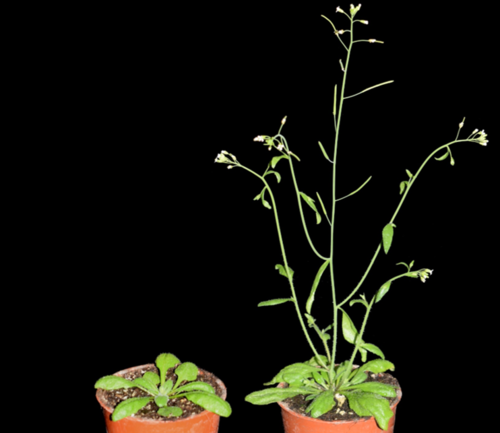How Plants Go Through Puberty
A research team at Freie Universität Berlin discovers genes that regulate plant development and reproduction
№ 001/2022 from Jan 04, 2022
Biologists at Freie Universität Berlin have discovered that the hormone cytokinin regulates a developmental process in plants that can be compared with puberty in humans and animals. The research team says that plants become receptive to specific signals that stimulate flowering during this development – in other words, they begin their transition into the reproductive phase. These signals include factors like day length, light intensity, and temperature. Certain hormones also influence this process. The research outcomes show that the hormone cytokinin plays a key role in a plant’s transition to the adult phase. The research team has thus been able to make a significant contribution to our understanding of “puberty” in plants. The study was published in Nature Communications.
Flowering is a very energy-intensive process for plants that requires precise timing, explains Dr. Thomas Schmülling, a professor of biology at Freie Universität Berlin and senior author of the study. Just like the human body changes throughout puberty, the plant’s appearance also transforms, especially its leaves. After germination, plants undergo a vegetative phase, during which the leaves needed for photosynthesis are formed. But how exactly do plants manage the transition to the adult phase in which they become receptive to flowering signals?
In order to answer this question, researchers at Freie Universität Berlin carried out experiments using the model plant Arabidopsis thaliana (also known as thale cress). They observed that plants of this genus with an increased cytokinin level or stronger cytokinin signals due to genetic mutations transition earlier to the adult phase than wild-type varieties of the plant. Plants with lower hormone levels, in contrast, spend longer in the juvenile phase so that flowering is delayed. By means of genetic analyses, the biologists succeeded in determining which individual genes involved in the hormone balance of thale cress are specifically needed to regulate the developmental transition. They identified certain cytokinin receptors and transcription factors that help translate the cytokinin signal into the formation of important proteins. Surprisingly, they also found that the transport of certain cytokinin forms from the root to the shoot seems to be essential in the transition to the adult phase.
How Cytokinin Works
Plants have a special signaling pathway that measures the age of the plant and helps regulate morphological changes during its development, explains lead author Dr. Sören Werner. This signaling pathway is made up of four different components – two small, regulatory nucleic acids, also known as microRNAs, and their respective target genes. Unlike messenger RNA molecules (mRNAs) that serve as a template for protein formation, microRNAs bind to precisely these mRNAs and prevent their translation into a protein. Dr. Werner says that cytokinin controls the formation of one of the two microRNAs involved and thus regulates its target genes. The authors of the study succeeded in linking the regulatory activity of cytokinin, which is well-established knowledge, with the microRNAs that were discovered later on. The research team was therefore able to reveal crucial components of the cytokinin signaling pathway and the age-dependent signaling pathway, as well as their convergence point.
Potential Areas of Application
Professor Schmülling says that the research outcomes could be applied to the cultivation of agricultural crops. The flowering time is an important characteristic in agricultural plants as it limits the ability to grow them in some regions. With the aid of this newly discovered signaling pathway, agricultural experts could specifically select plants for cultivation that flower earlier and have shorter generation periods. Delaying the flowering process by extending the juvenile phase could also be commercially profitable; for example, a longer vegetative phase could result in the formation of greater quantities of biomass as a renewable energy source. All of this means that the research team’s findings represent not just a step forward in plant research, but could also offer a whole range of practical uses in the world of agriculture.
Press Image
The transition to flowering is regulated by the hormone cytokinin in the model plant Arabidopsis.
Image Credit: Research team at Freie Universität Berlin / Sören Werner
This image is available for download by the media and free of charge if used in the context of a press release.
Further Information
Publication
Werner S., Bartrina, I., Schmülling T. (2021) Cytokinin regulates vegetative phase change in Arabidopsis thaliana through the miR172/TOE1-TOE2 module. Nature Communications 12, 5816. https://doi.org/10.1038/s41467-021-26088-z
Contact
Prof. Dr. Thomas Schmülling, Institute of Biology at Freie Universität Berlin, Email: tschmue@zedat.fu-berlin.de

